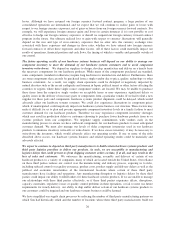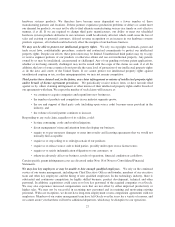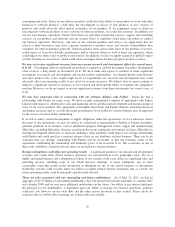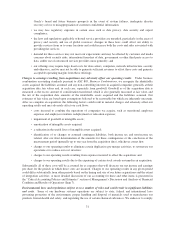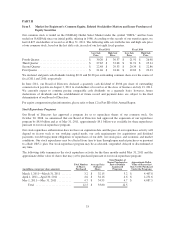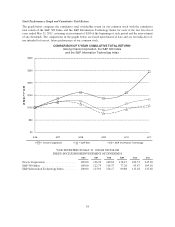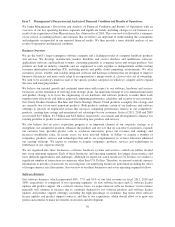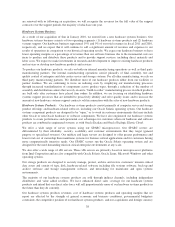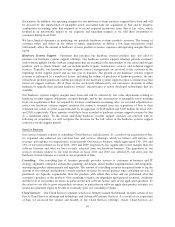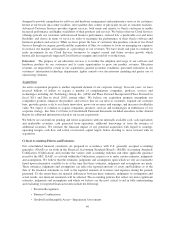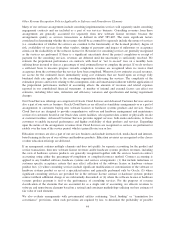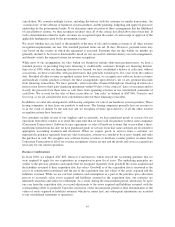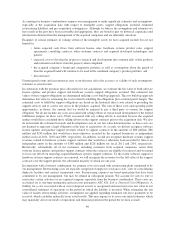Oracle 2011 Annual Report Download - page 38
Download and view the complete annual report
Please find page 38 of the 2011 Oracle annual report below. You can navigate through the pages in the report by either clicking on the pages listed below, or by using the keyword search tool below to find specific information within the annual report.
Item 7. Management’s Discussion and Analysis of Financial Condition and Results of Operations
We begin Management’s Discussion and Analysis of Financial Condition and Results of Operations with an
overview of our key operating business segments and significant trends, including changes to our business as a
result of our acquisition of Sun Microsystems, Inc. (Sun) in fiscal 2010. This overview is followed by a summary
of our critical accounting policies and estimates that we believe are important to understanding the assumptions
and judgments incorporated in our reported financial results. We then provide a more detailed analysis of our
results of operations and financial condition.
Business Overview
We are the world’s largest enterprise software company and a leading provider of computer hardware products
and services. We develop, manufacture, market, distribute and service database and middleware software;
applications software; and hardware systems, consisting primarily of computer server and storage products. Our
products are built on industry standards and are engineered to work together or independently within existing
customer information technology (IT), including private and public cloud computing, environments. We offer
customers secure, reliable, and scalable integrated software and hardware solutions that are designed to improve
business efficiencies and more easily adapt to an organization’s unique needs, at a lower total cost of ownership.
We seek to be an industry leader in each of the specific product categories in which we compete and to expand
into new and emerging markets.
We believe our internal growth and continued innovation with respect to our software, hardware and services
businesses are the foundation of our long-term strategic plans. An important element of our continued innovation
and product strategy is to focus the engineering of our hardware and software products to make them work
together more effectively and deliver improved computing performance, reliability and security to our customers.
Our Oracle Exadata Database Machine and Oracle Exalogic Elastic Cloud products exemplify this strategy and
are currently two of our most important products. Both products combine certain of our hardware and software
offerings to provide an engineered system that increases computing performance relative to our competitors’
products, creating time savings and operational cost advantages for our customers. In fiscal 2011, 2010 and 2009
we invested $4.5 billion, $3.3 billion and $2.8 billion, respectively, in research and development to enhance our
existing portfolio of products and services and to develop new products and services.
We also believe that an active acquisition program is an important element of our corporate strategy as it
strengthens our competitive position, enhances the products and services that we can offer to customers, expands
our customer base, provides greater scale to accelerate innovation, grows our revenues and earnings, and
increases stockholder value. In recent years, we have invested billions of dollars to acquire a number of
companies, products, services and technologies that add to, are complementary to, or have otherwise enhanced
our existing offerings. We expect to continue to acquire companies, products, services and technologies in
furtherance of our corporate strategy.
We are organized into three businesses—software, hardware systems and services—which are further divided
into seven operating segments. Each of these businesses and operating segments has unique characteristics and
faces different opportunities and challenges. Although we report our actual results in U.S. Dollars, we conduct a
significant number of transactions in currencies other than U.S. Dollars. Therefore, we present constant currency
information to provide a framework for assessing how our underlying businesses performed excluding the effect
of foreign currency rate fluctuations. An overview of our three businesses and seven operating segments follows.
Software Business
Our software business, which represented 68%, 77% and 81% of our total revenues in fiscal 2011, 2010 and
2009, respectively, is comprised of two operating segments: (1) new software licenses and (2) software license
updates and product support. On a constant currency basis, we expect that our software business’ total revenues
generally will continue to increase due to continued demand for our software products and software license
updates and product support offerings, including the high percentage of customers that renew their software
license updates and product support contracts, and due to our acquisitions, which should allow us to grow our
profits and continue to make investments in research and development.
36


